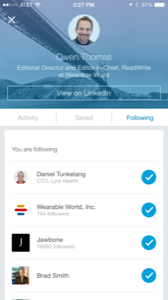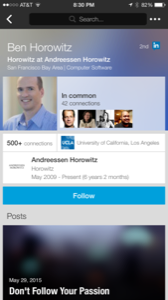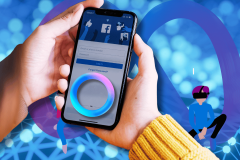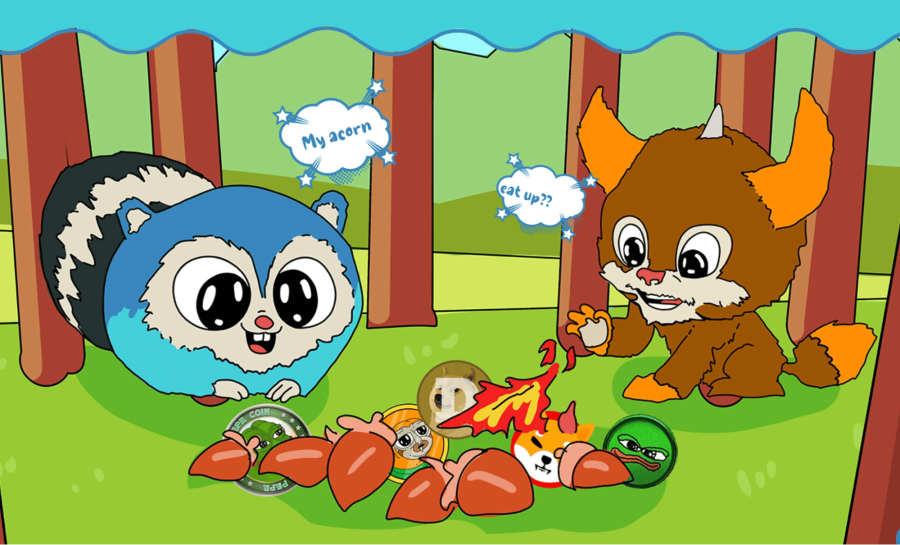Only connect? Not on LinkedIn’s mobile apps, which are pushing users to think differently about their professional connections.
On both the revamped Pulse news reader it launched Tuesday and its core mobile app, LinkedIn now encourages you to follow people, like you do on Twitter, rather than connecting with them.
Since its earliest days, LinkedIn has trained its users to form two-way connections with coworkers and other contacts to help it build out a map of professional connections. But with more than 360 million members spread around the world, that two-way model makes less and less sense.
Follow Me, Don’t Friend Me
There are three obvious reasons why LinkedIn is doing this. The first is the success of social apps like Twitter and Instagram, which don’t require two-way connections for users to signal interest in a person or a company by following their account. (Even Facebook now offers options to follow people, Twitter-style.)
The second is LinkedIn’s push into letting users publish original content, which requires a mechanism to let those budding authors build an audience beyond people they know firsthand through their work.
And the third is the increasing presence of companies as content publishers on LinkedIn. LinkedIn has offered a follow button for companies for years, allowing job candidates, employees, and partners to keep track of their activities. A “connect” option simply wouldn’t make sense for companies.
The follow model also solves a problem for LinkedIn as a news distributor: One’s LinkedIn connections may simply not be that interesting. As Pulse cofounder Akshay Kothari told ReadWrite, as his team was building the new app, many LinkedIn members told them they simply didn’t care about articles shared by people they happened to be connected to.

LinkedIn’s Pulse app, designed to find professionally relevant articles, makes the follow function obvious. You can now follow other people by clicking a plus sign next to their profile photo, and even look at the list of people—and companies—they follow to add more.

LinkedIn’s mobile app, meanwhile, now features a big “Follow” button when you visit someone’s profile. The option to connect to them—a two-way process which requires them to accept the request, like Facebook friend requests—is hidden behind a menu in the upper right-hand corner of the screen.
On LinkedIn’s desktop site, the opposite remains true: The follow button requires several clicks to discover on profiles, and is primarily featured on posts people write using LinkedIn’s publishing tools.
The follow button dates back to LinkedIn’s introduction of Influencers, a handpicked set of business celebrities who were the first people allowed to publish original content on the site. Their profiles looked different from ordinary members, with a prominent follow button and a hidden option to connect.
In the future, we may all be Influencers. Already, on LinkedIn’s mobile app, ordinary members and Influencers have similar profile designs, with a prominent follow button.
LinkedIn may be betting that mobile users may be more willing to experiment with a core function of LinkedIn than desktop users. (A LinkedIn spokesperson wasn’t immediately available to discuss the follow button Monday evening, when we requested comment.)
LinkedIn doesn’t appear to have played up the change, and it’s not clear when the company changed its mobile app to feature a follow button on profiles. The version history of its iOS app only mentions “bug fixes and performance fixes” in recent updates.
It’s an enormous challenge to retrain users, which may explain why LinkedIn has moved so slowly and quietly to make these changes. The LinkedIn connection request, for better or for worse, has become a part of popular culture: Look at Bloomberg Businessweek’s recent epic magazine-length article, “What Is Code?”, where a mythical Man In A Taupe Blazer’s number of LinkedIn connections becomes an object of fascination.
Sorry, Businessweek readers: The Man In The Taupe Blazer is already counting his LinkedIn followers. You might as well get up to speed.
Lead photo by Transformer18; screenshots by Owen Thomas for ReadWrite





















